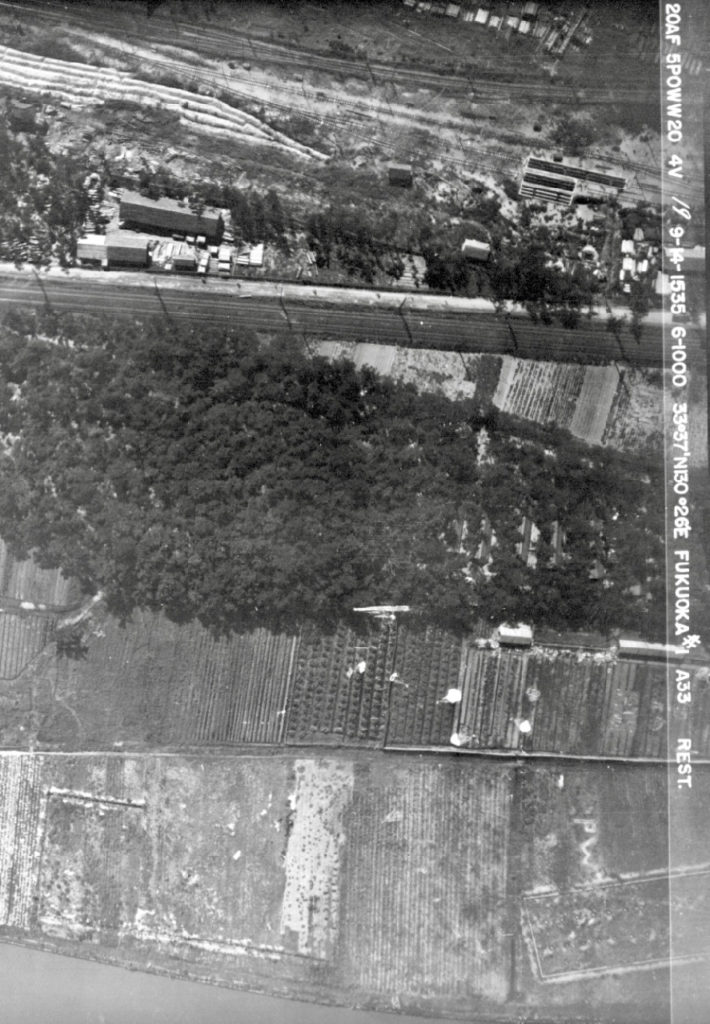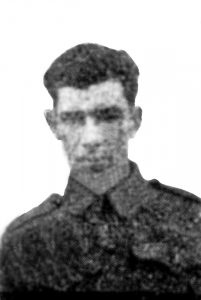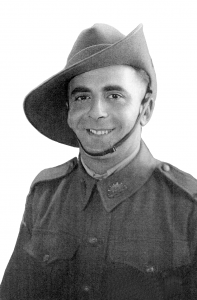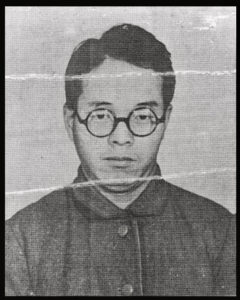Fukuoka sub-Camp No.1-B- Japan
Fukuoka, Fukuoka #1-B- Japan
Established as Kumamoto Branch Camp of Yawata Temporal POW Camp at Aza-Saburotsuka, Kengun-cho, Kumamoto City, Kumamoto Prefecture on November 26, 1942.
Reorganised to be Kumamoto Branch Camp of Fukuoka POW Camp on January 1, 1943.
Renamed as Fukuoka No.1 Branch Camp on March 1, 1943.
The POWs were used by Seibu District Army and engaged in the work of construction of Kengun Airfield in Kumamoto City.
Moved to Tatara-cho, Kasuya-gun (current Tatara, Higashi-ku, Fukuoka City), Fukuoka Prefecture on September 20, 1943.
Moved to Oaza-Mushiroda, Fukuoka City on April 17, 1944.
Moved to Hakozaki-cho, Higashi-ku, Fukuoka City on January 20, 1945.
Below: POW barracks amongst pine trees, PW sign and parachutes delivering relief supplies in field taken 14 Sep 1945. (With thanks and acknowledgement to Mansell’s Website.)
The POWs were used by Seibu District Army.
381 POWs (153 American, 140 British, 58 Dutch, 28 Australian and 2 other nationality) were imprisoned at the end of the war.
147 POWs died while imprisonment – conditions were difficult – there were no medical supplies, and for the Australians they did not have a senior officer; the bashings and violence towards POWs was extreme.
There were 2 POWs from 2/4th at this camp Joe Swartz and Bill Dwyer. Bill Dwyer WX20076 died of acute colitis on 5 May 1945 at 38 years. At the same time, Joe Swartz WX4924 was moved to Moji camp No. 4. Both men had worked on Burma-Thai Railway and survived with ‘D’ Force, V Battalion.
Dwyer and Swartz arrived Moji with Aramis Party and initially send to Omuta No. 17 Camp prior to arriving No. 1.
Below are three Affidavits by Australians who were POWs at Fukuoka No. 1 Camp – THESE AFFIDAVITS HAVE BEEN COPIED FROM THE MANSELL WEBSITE – WE WISH TO ACKNOWLEDGE THIS WEBSITE WHICH CONTAINS THE MOST DETAILED INFORMATON ABOUT POW CAMPS IN JAPAN. http://mansell.com/pow_resources/camplists/fukuoka/fuk_01_fukuoka/fukuoka_01/Page02.htm
Right: Bill Dwyer from WA Goldfields who died illness 5 May 1945 at this Camp on aged 38 years. His ashes were brought out of Japan and were eventually taken to Labuan.
Below: Swartz fortunately survived to return home,.
Please read further about living and discipline at Fukuoka 1
Pte. Jack Dilger
WAR CRIMES
AFFIDAVIT OF TX 8395 PTE. DILGER J.A. 2/40 INF. BN. A.I.F.
On the 3rd day of April 1946, Jack Allan DILGER of 21 Cressy St. NEW TOWN, HOBART, TASMANIA, soldier, whose Regimental Number is TX 8395, being duly sworn makes oath, and says as follows:
-
I am TX 8395 PTE. DILGER J.A. a former Prisoner of War in Japanese hands, held in No. 1 Camp Fukuoka. We did not have an Australian officer in this Camp, being very few in numbers.
-
CONDUCT OF THE CAMP.
The discipline in this Camp administered by the Japanese was very brutal in every respect. All P.O.W. Officers in this Camp were treated very little different to Other Ranks. They had to carry out instructions given them by the Japanese in the same way as O.Rs. All P.O.Ws. including Officers, had to salute the lowest ranking Jap., and take “bashings” when at fault. Jap Guards patrolled through the huts at short intervals, and whenever the Guard entered the hut all men had to jump to his feet and shout the word of salute and bow. If any man was slow at doing so or at fault, he was immediately punished. This caused innumerable “bashings”.
-
PARADES
Parades were held twice a day. We had to double from our huts on to the parade ground, and when “Fallen In” we would have to stand at “attention” in all kinds of weather for an hour at a time without moving. Any one making the slightest movement or speaking whilst on parade would be ill treated in a very cruel way, such as use of butt of rifle, hitting the men with their fists, and bamboo poles. All ranks were treated in this manner whether they were sick or otherwise.
-
MESSING
Messing arrangements were very bad. All ranks messed in their sleeping huts. The kitchens were about 100 yds. from the sleeping huts, and the Mess Orderlies had to carry the food in wooden containers which was always stone cold by the time it reached us. These containers were always in a filthy condition because of the very unhygienic arrangements for the cleaning of same. The only facility for washing these containers was a shallow well dug for this purpose. The waste water had to be emptied into a drain along side the well. No brushes, scrubbers or washers were supplied to carry out this very necessary work.
-
RECREATION
Recreational periods allowed in accordance with Japanese Army Regs. were one day off in ten. These were arranged to be taken off when it was wet, which prevented us from doing our washing and getting it dry. During the period we were in THAILAND we actually went for 90 days without having one day off. The Japanese Camp Commandant barred all sports and amusements, not even allowing cards to be played in the huts.
-
ABLUTIONS AND LATRINES.
Ablutions were filthy. Crude bamboo benches were used and very seldom cleaned. The water was thrown anywhere and not into proper drains which made it very muddy. When any cleaning was done on these ablutions, it was carried out by the sick men left in the huts. They were forced to do it by the Guards.
Latrines used were the trench style. They were about 8′ deep and each side was lined off with bamboo poles. No disinfectants were used, and when filled, very thin layers of earth was placed over each latrine, not more than about 6″ in thickness.
In Japan at FUKUOKA Camp, latrines were dug about 4′ deep and then lined with cement. These were emptied daily by the Sick men of the Camp, using wooden buckets and dippers, and carried to a pit on the side of the road just outside the Camp entrance where it was collected by the Japanese civilians to be used in gardens. No coverings for these pits were provided, they being open all the time.
-
MEDICAL TREATMENT
Only a limited number of men were allowed sick in Camp. All men parading sick were classed by the Jap. M.O. Frequently the Jap. M.O. failed to come to the Camp for 3 to 4 days at a time, the result being that very sick men were forced to go on work parties until such times when the Jap. M.O. returned to Camp. This resulted in men collapsing at work, and on several occasions men died shortly after being brought back to Camp. Medical supplies were very short until just before the War ended, when all Medical Establishments were overstocked.
-
ILL TREATMENT
Ill treatment in this Camp was very frequent. The main method of torture was bashings with bamboo poles and pick handles, in fact it was a daily occurrence. One incident that I can well remember in FUKUOKA Camp is the terrible bashing metered out to two Dutchmen. In this Camp there were two separate Guards, one from Fighting Troops, the other was a Civilian Guard made up of older soldiers who had served in China. It appears that these Civilian Guards would go to the kitchen and pilfer rations and sell them to favoured P.O.Ws. Two Dutchmen made a complaint to the Jap. Camp Commandant, who in turn had the Civilian Guards paraded before him, they were reprimanded. As a reprisal, the Civilian Guard would get these two Dutchmen nightly and stand them up against the wall and bash them with bamboo poles for anything up to 1/2 hour until they were exhausted.
During Feb. 1944, at FUKUOKA Camp, one dinner time, two Dutch Soldiers and two American Soldiers were taken by the Japanese Guard known as “BASHER” between two huts and made get on the ground on their hands and feet. Whilst in this position they were flogged by “BASHER” across the back and legs until they collapsed. One Dutch Soldier had to be carried home on a stretcher for a distance of 5 miles and placed in Camp Hospital in FUKUOKA Camp, and later admitted to a General Hospital where he died. One of his legs had the muscle torn away from behind the knee that the sinews were exposed. His death was due to the severe treatment he received from “BASHER”.
Another incident that happened on the Aerodrome at FUKUOKA, “BASHER” flogged another P.O.W. with a bamboo pole until both his legs were broken also his back. This P.O.W. was not brought back to Camp after the flogging, but taken to a Jap. Hospital where he died shortly afterwards. I did not witness this incident, but other evidence may be obtained to support this statement.
Further evidence could be obtained from the Dutch Medical Officer, Capt. ENSING of the Dutch Army, who had charge of a section of men of the Camp, acting as M.O. under the command of the Jap. Medical Officer.
-
PERSONS WHO COMMITTED THE CRIMES.
Name — Known as “BASHER” and the “BULL”
Height — about 5’3″
Age — 24 years approx.
Description — Thick set, dark and Bull faced.
-
CAMP COMMANDANT
I cannot remember his name. He was a maniac, was relieved of his job about 2 months before the war ceased. New Jap. Commandant was very decent, that is as far as Japs. go. His height was about 5’11”, weight about 12½ stone, age 32 years approx.
Sworn by the Deponent on the day and year 3rd April 1946, first before mentioned at Hobart.
Before me
(signed) J. R. Kinlo J.P.
(signed) J. Dilger
__________
Sgt. Peter French
On this 12th day of June 1946, Peter Russell French, of “Murungha” Carroll Gap, in the State of New South Wales, grazier, makes oath and says as follows:
1) My former military status was:
No. NX. 32834
Rank. Sergeant
Unit. 2/20 Bn.
2) I was captured on SINGAPORE on 15 Feb. 42.
3) On the 9th of September 1944 I was transferred to Fukuoka Camp No. 1 in Japan, where the undermentioned events took place. I was at this camp until I was liberated.
4) HATA MATSATO [Masato] was a medical orderly in Fukuoka Camp No. 1, and was responsible for physical training in the camp.
5) During the winter months, December 1944, January and February 1945, we had to do physical training daily.
6) S/Sgt. SIMS was suffering from a chill in the stomach. SIMS told HATA MATSATO that he was ill, but was told to go on parade. As he made his way on to the parade ground HATA MATSATO started to bash him with a stick.
S/SGT. SIMS was unable to carry out the physical training and HATA MATSATO bashed him again with a stick.
V7) On numerous subsequent occasions, S/SGT. SIMS was bashed by HATA MATSATO for not being able to do the physical training.
8) Approximately six weeks after he received the first bashing, S/SGT. SIMS went to hospital suffering with beriberi, from which he did not recover.
9) After the capitulation of the JAPANESE, I, with a party of other soldiers discovered a large quantity of Red Cross supplies consisting of M & B tablets, quinine, sulphanilimide powder and vitamin tablets.
10) HATA MATSATO was in charge of the Red Cross Supplies at this camp, and had withheld their distribution to us.
11) On one occasion I heard CAPT. WALLACE of the RMC ask HATA MATSATO for a supply of sulphanilimide powder. HATA MATSATO refused to give CAPT. WALLACE any of the powder.
12) KATSURO [Katsura] TAKEO was the official interpreter at Fukuoka Camp No. 1.
13) I have seen KATSURO TAKEO bash many prisoners, but I can not give the name of any of the victims. I did not see him kill anyone or torture anybody.
14) BUCKTOOTH was a civilian guard at Fukuoka Camp No. 1.
15) Somewhere at the end of December 1944 or the beginning of January 1945 I saw BUCKTOOTH bash a Dutchman.
The Dutchman was trying to warm his rice at a fire when BUCKTOOTH came upon him. The Dutchman was bashed into unconsciousness and BUCKTOOTH would allow no one near him. When the Dutchman recovered, BUCKTOOTH bashed him again, using the butt of his rifle.
We were about ten miles from our camp at the time and BUCKTOOTH forced the Dutchman to march with us the whole distance. There was snow on the ground at the time about one foot thick.
On arrival at camp, the Dutchman was put into hospital but died two days later.
I do not know the name of the Dutchman.
Sworn by the abovenamed deponent
Peter Russell French at TAMWORTH
on the 12th day of June 1946.
Signature of deponent.
BEFORE ME. (signed) J. W. Collins
A Justice of the Peace.
__________
Geoffrey Thomas Underwood
I, Geoffrey Thomas UNDERWOOD of Evandale, HUGHENDEN in the State of QUEENSLAND, and formerly QX11013 Gnr UNDERWOOD, G.T., 2/10 Fld. Regt., now discharged, being duly sworn, make oath and state as follows:
-
From early December one thousand nine hundred and forty four until approximately the Twenty first of June one thousand nine hundred and forty five I was a Prisoner of War at FUKUOKA Camp No. 1 in which camp were approximately one thousand two hundred Officer and other rank Prisoners of War of English, American, Australian and Dutch nationalities.
-
We were employed as labourers building the camp itself and later loading, unloading and stacking timber in a timber yard.
-
General conditions in this camp were bad. The food was particularly poor in quality. A mixture of inferior quality wheat, barley, rice and the Japanese equivalent of milo plus DIAKON (Phonetic) or Horse Radish served in one pint measures three times daily plus half a pint of watery weed and seaweed (Soup) formed the average meal served three times daily. This ration was only supplemented once weekly by a small cooked fish about the size of a small sardine. Although the quantity may appear liberal (One pint per meal) the quality of the mixture was such, that a bucketful would not have satisfied our hunger.
-
Red Cross parcels were issued twice during this period, the first occasion on the twenty fifth day of December, one thousand nine hundred and forty four, the other exactly one month later. All Prisoners of War began to show symptoms of starvation, many became ill and at least three Prisoners of War died as a result of the diet on which we were forced to work hard for long hours.
-
The accommodation was bad with one exception, it was weather proof. It was a barn like wooden shell and apart from the wooden shelves raised from the floor upon which we slept no articles of furniture or amenities were available. Taps were continually frozen, and no hot water was available. Clothing was inadequate for the severe winter climate. We were only allowed wear greatcoats in camp and then only during certain hours.
-
We were plagued by fleas and spent most of the nights miserably and sleepless because of the countless flea bites.
-
The only clothing issued by the Japanese were inferior quality work dress. No footwear was issued during this period.
-
Medical supplies were practically nil. The only medicines I recall having seen was a small quantity of aspirin. Many Prisoners of War were suffering from diarrhoea, dysentery, beri beri and malnutritional diseases but no medicines were available for their treatment. VX36824 Gnr L CHALKER, 4 A/Tank Regt; WX20076 Pte W. DWYER, 2/4 M.G. Bn; and S/Sgt SIMS were all suffering badly from malnutrition and diarrhoea.
-
Despite many pleadings on their behalf to the Camp Commander commonly known to Prisoners as “THE OLD MAN” nothing was done for them.
-
S/Sgt SIMS eventually collapsed and was admitted to the crude camp Hospital where he died a few days after his admittance. Shortly after his death approximately fifty American Officers were brought into the camp in an exhausted condition. They had been wrecked at sea and apparently had gone through a terrific ordeal. They were admitted to hospital and apparently the Japanese considered that the hospital was full. CHALKER and DWYER became very ill and, at times, were unable to move about but were still forced to work. Eventually CHALKER collapsed and was admitted to the hospital where he lay almost unattended for three days before he died. DWYER also collapsed and died within a few days of his admittance. “THE OLD MAN” relied greatly upon his interpreter named KATSURA (Phonetic) who spoke fluent English with an American accent, so much that KATSURA ran the camp. Most of the ill treatment I saw in this camp came from his hands or through his instructions.
-
-
I remember on one occasion I was pushing a truck; I was weak at the time and stopped pushing to regain my breath. KATSURA came up behind me and knocked me unconscious with a shovel. He struck me several blows across the head with this instrument before I dropped. I have often witnessed KATSURA strike many other Prisoners of War in a similar manner.
-
Most of the guards in this camp were changed at frequent intervals however, a few were more or less permanent; of those a guard known as “BUCK TOOTH” was well known to Prisoners of War. “BUCK TOOTH” was a particularly uncouth and brutal man. He accepted every opportunity given to inflict punishment on the weak and starving Prisoners of War. He frequently assaulted myself for trivialities and was a source of worry and fear among the Prisoner of War population.
-
A description of the Camp Commander commonly known to Prisoners of War as “THE OLD MAN” is as follows:-
Age, approximately Thirty five years; Height approximately five feet five inches; Thick set, medium to heavy build. Dark Complexioned and rather strong handsome features by comparative Japanese standards.
-
A description of the Interpreter known to Prisoners of War as KATSURA is as follows:-
Age approximately forty five to fifty years; height approximately five feet three inches; heavy build, broad shoulders, heavy corporation, thin legs, spoke fluent English with American accent. Was a three star private.
-
A description of the Guard known to Prisoners of War as “BUCK TOOTH” is as follows:-
Age approximately forty years; height approximately five feet eleven inches; Powerful build, prominent buck Teeth, broad forehead tapering down to a pointed chin. From his actions was considered to be slightly insane.
I swear that the contents of this my affidavit are to the best of my knowledge and belief true and correct in every particular.
SIGNED and SWORN by the within-named Deponent at BRISBANE on the ?? day of August 1947.
(signed) G. Underwood
Before me (signed) A. H. Deakin?
A Justice of the Peace.
__________
Below: HATA MATSATO




